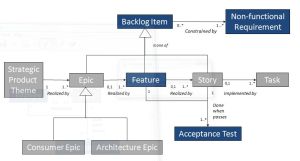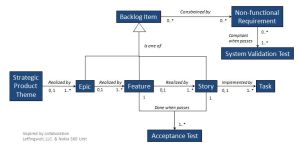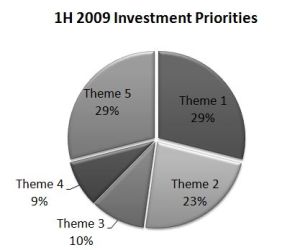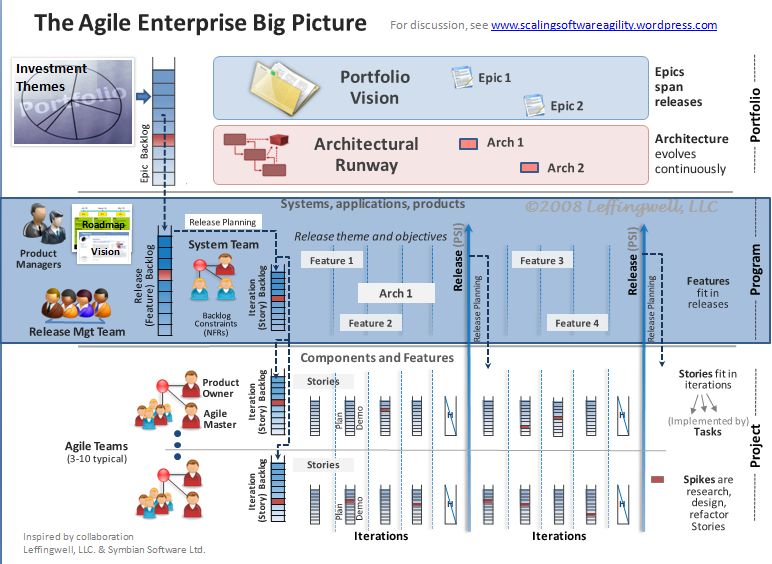Note: This is the fourth in a series of posts describing, in more rigorous terms, the Lean, Scalable Requirements Information Model for the Agile Enterprise (AE RIM) that underlies the Big Picture Series. As I’ve noted, I’ve been collaborating in this series with Juha-Markus Aalto, Director of Operational Development for Nokia S60 Software Unit, where a variant of the model is being developed and applied on a large scale (very large- affecting thousands of practitioners) development project.
In the last post, the Subset for Agile Teams we described the model as it applies to Agile Project Teams. In this next post, we move up one level in the Big Picture (see graphic below) and describe how the model is applied at the Program Level.

Agile Enterprise Big Picture with Program Level Highlighted
But first, for convenience, we’ll take a quick look again at the base model.

Base Requirements Information Model
Note: as the model is being elaborated in earlier posts, it is being refined with additional model elements and relationships, but I’ll continue to use the summary version (base) model here for simplicity.
The Program Level.
As can be seen in the Big Picture, we assume that a significant number of Agile Teams are collaborating in a Program building an enterprise-class System of substantial complexity. We described the teams use of a quintessentially agile model subset (Story, Task, Backlog Item and Acceptance Test) in the last post. At the Program Level, we’ll introduce the additional elements of Feature, Backlog Item (in this case, Feature backlog item) and Non-Functional Requirement.

Feature
In describing the features of a product or system, we leave the world of small team agile (where most everything is a Story) and take a more abstract and higher level view of the system of interest. In so doing we have the security of returning to a more traditional description of system behavior. There is certainly some comfort in knowing that while agile changes most everything, it needn’t change absolutely
everything we have learned prior, including what has been well described in software requirements texts (for example: Managing Software Requirements: A Use Case Approach: Leffingwell and Widrig). In that text, Features were described as:
Services provided by the system that fulfill a user need.
They lived at a level above software requirements and bridged the gap from the problem domain (understanding user needs) to the solution domain (specific requirements intended to address the user needs) as the graphic below shows:

"Requirements Pyramid" from Managing Software Requirements, by Leffingwell and Widrig, Addison-Wesley 2003.
We also posited in that text that a system of arbitrary complexity can be described with a list of 25-50 such features. (Note, however, that in the Big Picture, Features are sized to fit within release boundaries, so that a release can be described in terms of a list of just a few features).
That simple rule of thumb allowed us to keep our high level descriptions exactly that, high level, and simplified our attempts to describe complex systems in a shorter form. Of course, in so doing we didn’t invent either the word “Feature” or the usage of the word in that text. Rather, we simply fell back on industry standard norms to describe products in terms of, for example, a Features and Benefits Matrix that was often used by product marketing to describe the capabilities and benefits provided by our new system. By applying this familiar construct in agile, we also bridge the language gap from the agile project team/product owner to the system/program/product manager level and give those who operate outside our agile teams a traditional label (Feature) to use to do their traditional work (i.e. describe the thing they’d like us to build).
Even more conveniently, we also provide a surface to organize agile teams around – the Feature Team, which is an agile team organized for the purpose of delivering a set of features to end users – see Larmon & Vodde-Scaling Lean and Agile Development, Highsmith- Agile Project Management and Leffingwell-Scaling Software Agility. (Note: in my latter text, though, I described teams more commonly as agile component teams, but noted that these teams could be organized around Features, Components, Subsystems, or whatever made sense to the system context).
Whether by serendipity or intent, the ability to describe a system in terms of its proposed features and the ability to organize agile teams around the features gives us a straightforward method to approach building large-scale systems in an agile manner.
The Feature Backlog
Returning to the Backlog and Feature model elements:

We can see two obvious implications.
- Features are realized by Stories. At release planning time, Features are decomposed into Stories, which is the team’s implementation currency. (In a large system, there may tens and even hundreds of Stories necessary to realize a Feature)
- Planned Features are stored in a Backlog, in this case the Feature (Release) Backlog.
In backlog form, Features are typically expressed in bullet form, or at most, in a sentence or two. For example, you might describe a few features of Google Mail something like:
- Provide “Stars” for special conversations or messages, as a visual reminder that you need to follow-up on a message or conversation later.
- Introduce “Labels” as a “folder-like” conversation-organizing metaphor.
Expressing Features in Story Canonical Form
As agilists, however, we are also comfortable with the suggested, canonical Story form described in the last post:
As a <role> I can <activity> so that <business value>
Applying this form to the Feature construct can be also to help focus the Feature writer on a better understanding of the user role and need. For example:
As a modestly skilled user, I can assign more than one label to a conversation so that I can find or see a conversation from multiple perspectives
Clearly there are advantages to this approach. However, there is also the potential confusion from the fact that Features then look exactly like Stories but are simply written at a higher level of abstraction. But of course, that’s what they really do represent!
Testing Features
In the last post, we also reintroduced the agile mantra all code is tested code and illustrated the point with the base model:

This illustrates a Story cannot be considered Done until it has passed one or more acceptance tests.
At the Program level, the question naturally arises as to whether or not Features also deserve (or require) Acceptance Tests. The answer is, most typically, yes. While story level testing should assure that the methods and classes are reliable (unit testing) and the stories suits their intended purpose (functional testing) , the fact is that the Feature may span multiple project teams and many, many (tens to hundreds) of stories.
While perhaps ideally, each project team would have the ability to test the Feature at the system level, the fact is that that is often not practical (or perhaps even desirable – after all, how many teams would we want to continuously test the same feature!). Many individual project teams may not have the local resources (test bed, hardware configuration items, other applications) necessary to test a full system. Moreover, at scale, many teams are developing APIs, infrastructure components, drivers and the like based upon the architecture of the solution, and they may not even have an understanding of the full scope of the system Feature that drove their Story to exist. (If you don’t believe or agree with this, test the hypothesis by asking some newly hired teammates working on a new feature or component of a really big system to describe how or why a system-level feature works……).
In addition, there are also a myriad of system-level “what if” considerations (think unified process alternate use-case scenarios) that must be tested to assure the overall system reliability and some of these can only be tested at the full system level.
For this reason, Features typically require one or more functional acceptance tests to assure that the Feature meets the user’s needs. In practice, many of these tests may be implemented at a higher level in the hierarchy, at the Big Picture System Team level. (see below)

To reflect the addition of Acceptance Tests to Features, it is necessary to update the information model with an association from Feature to Accetpance Test as the grpahic below shows.

Revised Information Model, Adding Acceptance Tests to Features
In this manner, we illustrate that every Feature requires one or more Acceptance Tests, and a Feature cannot be considered Done until it passes.
Next- Nonfunctional Requirements in Agile
Well, that covers the Feature model element at the Program level. However, we have yet to explore another critical Program model element, the Nonfunctional Requirement. Since this post is already way too long, I’ll leave that for the next post in this series.




























